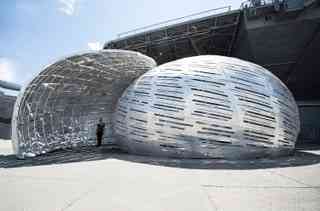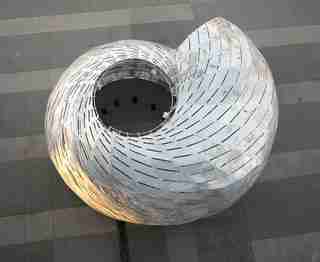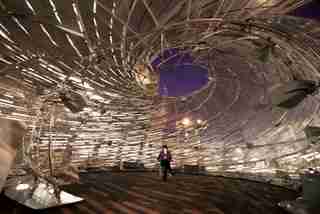
NASA’s Jet Propulsion Laboratory approached New York architecture and design firm StudioKCA with an unusual issue: How do you get people to interact with the 19 satellites the agency has orbiting in space?
“It’s a very interesting problem to address,” says principal Jason Klimoski, who led the project with fellow principal Lesley Chang. “How do you represent these orbital trajectories in a meaningful way?”

StudioKCA proposed the idea of a nautilus-shaped structure for what became the NASA Orbit Pavilion . “How do you talk about sound? We thought back to being a kid at the beach,” he says, noting that with shells, “You’re not listening to the ocean but have a little piece of the ocean with you. With this, you have a little piece of space with you.”
From there, they got involved with composer Shane Myrbeck, who created and assigned sounds to each satellite. “What these satellites reflect is data,” Klimoski says, adding that the structure includes dozens of speakers, which give the feeling of a three-dimensional chamber of sound. “It’s an interesting way to approach trying to understand space–through sound.”

The structure itself is a double-curved surface made out of 3,500 square feet of aluminum. The pieces were riveted and then stitched together on-site. Each of the tubes that make up the shell is curved to a different degree. “We make a lot of fixtures, so this was like building a massive lantern.”
The Orbit Pavilion made its debut in New York, and next it’s headed to the Huntington Library Botanical Gardens in San Marino, California. “I think that the shell is generating this curiosity about space—what’s out there that we can’t see. That’s been rewarding and positive.”
This wasn’t StudioKCA’s first time collaborating with NASA. Last year they worked together on an installation representing the Rosetta comet, which included folded steel plates, LED lights, a reflecting pool, and nearly 100 feet of copper tubes and misters.
And if it seems surprising that a scientifically focused organization like NASA would be using art to connect with people, it shouldn’t. “They’re creative people, and they’re looking for new and inventive ways to represent what they do,” Klimoski says. “They’re open to new and inventive ways to represent the data they’re collecting.”
